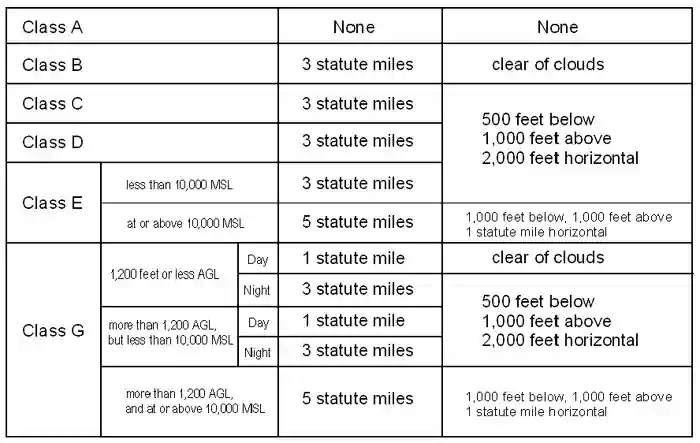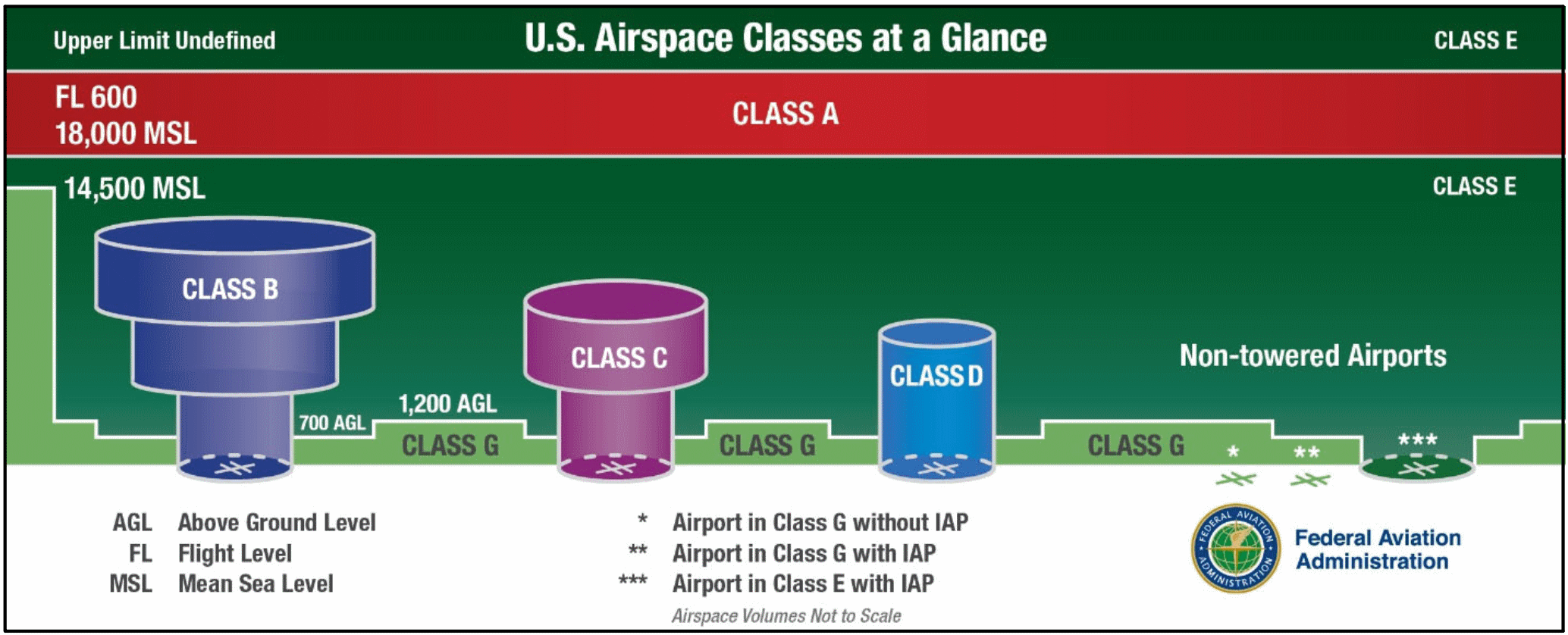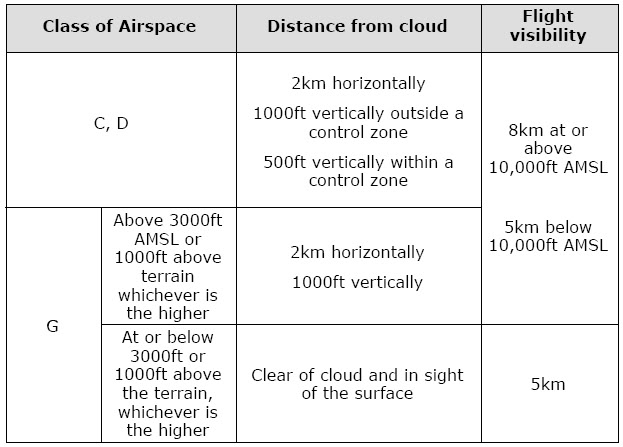class g airspace visibility requirements
For Class B C D and E airspace below an altitude of 10000 MSL the basic VFR weather minimums are. Day except as provided in 91155b 1 statute mile.
Class G minimum weather requirements exist so that you can see and avoid other aircraft.
. 500 feet below 1000 feet above 2000 feet horizontal. For aircraft other than helicopters. 1 statute mile horizontal.
At or above 10000 ft MSL. It extends from the surface to the base of the overlying Class E airspace. 12 rows Class C.
For other classifications of airspace visibility requirements increase during the night. Class G airspace is the only form of uncontrolled airspace in. Depending on how high you fly and the time of day within Class G airspace your visibility requirement could range anywhere from 1SM to 5SM.
Because starting at 10000 MSL you can fly faster than 250 knots and you need more visibility and distance from the clouds to see and avoid other. Air Traffic Control Facility. Less than 10000 feet MSL.
Class G 1200 feet or less above the surface regardless of MSL altitude. The requirements are slightly less restrictive in Class G airspace with a less restrictive daytime visibility below 10000 feet MSL 1 statute mile only and below 1200 feet AGL by day a less-restrictive separation from clouds clear of clouds with no distance-from-cloud requirements. On the other hand Class G airspace has four different sets of altitude-dependent minimums.
Night except as provided in 91155b 3 statute miles. One mile visibility and clear of clouds is the daytime requirement. Distance from clouds requirement 1000 ft above 1000 ft below 1 statute mile horizontal.
For any airspace that hasnt been designated as controlled as described above it. Visibility requirement 5 statute miles. 5000 feet AMSL up to 9500 feet AMSL.
You can remember Class G uncontrolled airspace because its just like the good old days at the dawn of aviation. Class G Airspace Boundaries of Class G Airspace. Less than.
In Class B airspace aircraft are required to remain. Class G Uncontrolled Class G is considered uncontrolled airspace but still has VFR weather minimums. No person may operate an ultralight vehicle when the flight visibility or distance from clouds is less than that in the table found below.
Because it is uncontrolled there are no communication requirements. 3 Main reasons about the further subdivision. Distance from clouds requirement 1000 ft above 500 ft below 2000 ft horizontal.
At night less than 1200 AGL in Class G airspace the helicopter flight visibility requirements are 1 statue mile visibility and cloud clearance requirements are to remain clear of clouds. Minimum Flight Visibility requirement. All operations in Class A Class B Class C and Class D airspace or Class E airspace designated for an airport must receive prior ATC authorization as required in 10317 of this part.
Class Alpha necessitates an instrument rating so no visual and cloud clearance requirements are essential in this airspace. At night requirements jump to three miles visibility and from merely clear of clouds to 500 feet below 2000 feet horizontal and. Class G airspace is not depicted on any chart.
This is for the reduced visibility caused by a dark environment. VHFor even HF radio requirement. Rules governing VFR flight have been adopted to assist the pilot in meeting the responsibility to see and avoid other aircraft.
Non-controlled Class G airspace is also subdivided vertically into operational spheres. 1200 or less above the surface regardless of MSL altitude Flight Visibility. Flight Rules Pilot Equipment Requirements.
Class E airspace starts at various altitudes but always exists above 14500 feet. Minimum flight visibility and distance from clouds required for VFR flight are contained in 14. Flight visibility of 3 statute miles SM Cloud clearance of 1000 above 500 below and 2000 horizontally except for class B which simply requires pilots to remain clear of the clouds.
And at or above 10 000 feet AMSL. A Unless otherwise specified in the certificate holders operations specifications when conducting VFR helicopter air ambulance operations in Class G airspace the weather minimums in the following table apply. At night less than.
However within ½ mile of the runway or helipad of intended landing a helicopter may be operated in an airport traffic pattern clear of clouds if the flight visibility is not less than ½. Class G airspace uncontrolled is that portion of airspace that has not been designated as Class A Class B Class C Class D or Class E airspace. Is the controlled airspace not classified as Class A B C or D airspace.
36 rows Class C. VFR Visibility and Cloud Clearance Minimums. Airspace Flight Visibility Cloud Clearance 10000 MSL E 5 statute miles 111 41000 below 41000 above 41 smhorizontal C D E B 3 statute miles Clear of clouds G night 3 statute miles 152 4500 below 41000 above 42000 horizontal G day 1 statute mile 152 4500 below 41000 above 42000 horizontal G night 3 statute miles 152 4500 below 41000 above 42000 horizontal.
In accordance with FAR 91155. VFR Minimum Visibility Above 10000 MSL. East ODD West EVEN level.
135609 VFR ceiling and visibility requirements for Class G airspace. At night requirements jump to three miles visibility and from merely clear of clouds to 500 feet below 2000 feet horizontal and 1000 feet above clouds. 500 Below 1000 Above 2000 Horizontal.
Day ½ statute mile. Day - 1 Statute Mile Night - 3 Statute Miles. At or above 10000 feet MSL.
Regulations Vfr Minimums Learn To Fly Blog Asa Aviation Supplies Academics Inc

Part 91 Subpart A General Operating And Flight
Class G E Vfr Visibility Requirements Cheat Sheet I Made R Flying
How To Remember Vfr Weather Minimums Bobbie Lind

Airspace Classes Explained The Ultimate Guide For Beginners
What Are The Basic Vfr Minimums Quora
What Is The Minimum Visibility For Landing Quora
How To Remember Vfr Weather Minimums Bobbie Lind
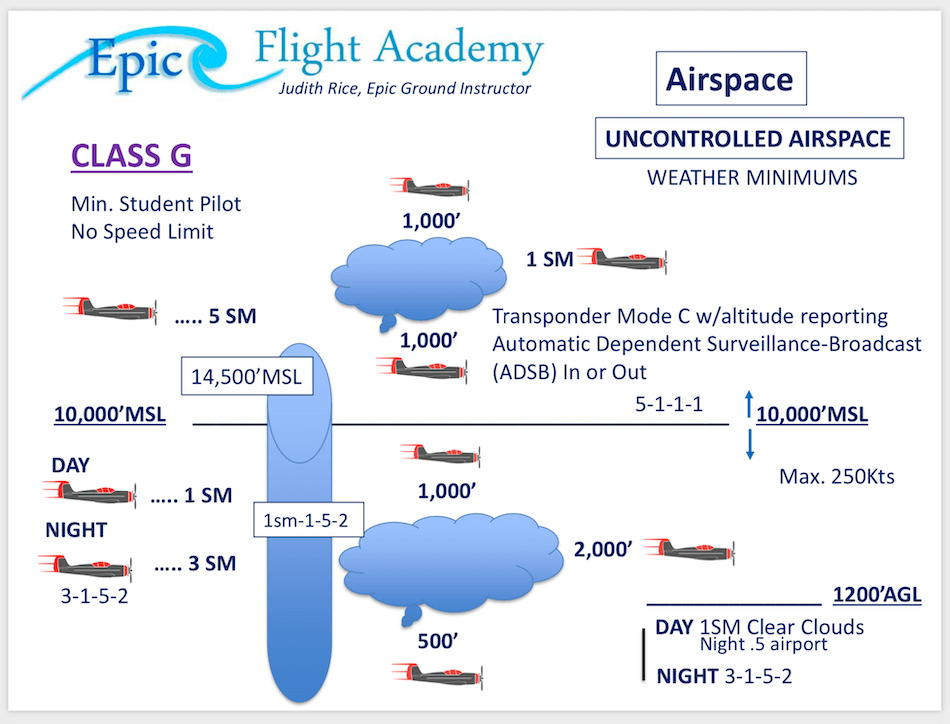
Airspace Classes And Special Use Airspace Everything There Is To Know

Helicopter Instrument Procedures Part Three

Class G Airspace Explained Boldmethod

Vfr Cloud Clearances Pilot Training For Ga

Why Are There Mandatory Cloud Clearance Requirements Boldmethod

Class G Airspace Explained Boldmethod
Helicopter Ground School Vfr Weather Minimums Rotorworks Inc

